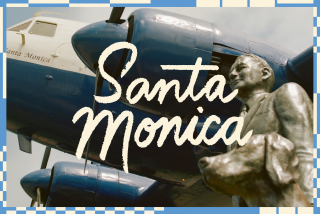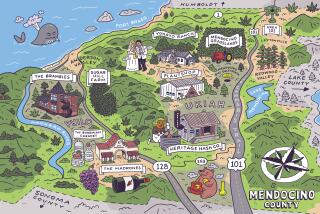A Toast to Home Brewers : Where Maltose Falcons Roost, Beer Isn’t Just a Drink, It’s a Passion
- Share via
WEST LOS ANGELES — Beer. It is food, a social culture, a miracle of science first discovered by Mesopotamians in 4000 BC.
So say the Maltose Falcons, one of the largest, oldest and most competitive home-brew beer clubs in the nation, whose members wax poetic about the beverage that binds them.
If observers were to take their cue from TV commercials, beer would be judged a low-brow brew guzzled by manly men with undiscriminating palates.
But that myth is quickly dispelled by any of the 300 Maltose Falcons members, the most active of whom gather monthly at the Home Wine & Beer Making Shop in Woodland Hills to listen to sermons on the virtues of proper brewing. The shop also sponsors Saturday “Bru Crus” where as many as 20 members brew batches of experimental beers on the shop’s brew system, which is followed by a potluck barbecue.
A thinking person’s beer drinker, the typical Falcon member is a brewer-connoisseur who looks at beer and brewing as the combination of art and science, a labor of love and always, a work in progress.
Take Mar Vista resident Biff Tate, a brewer of two years who makes about 10 gallons of beer twice a month, frequently in concert with other Westside members.
“The club really appreciates the miracle of nature processes involving cultures and fermentation like cheese, yogurt, wine and beer,” said Tate, who is fascinated by beer folklore and its sociocultural value. “We are not responsible for it, but we have harnessed it and appreciate it.
“And I am into the concept of beer as food, which is rooted in Europe, where it’s a part of daily life and respected for its nutritional benefits and stress release. The key attitude there is appreciation so that it is not abused or overused.”
Tate, who drinks about two beers a day, said he is trying to perfect a pale ale or “transition beer” for his wife, who drinks mostly commercial light beers. “I don’t want to scare her with color or a heavy port,” he said.
If club members have a common denominator, it is the desire to drink good-tasting, fresh-brewed beer and to become better brewers. Indeed, it is part of the mission statement of the club--founded by home-brew hobbyist Melvin Elhardt in 1974--to help each member fulfill his or her personal brewing potential with an educational approach to the craft.
There are 250 home-brew clubs in the nation, but Karen Barela, vice president of the American Homebrewers Assn., based in Boulder, Colo., said the Falcons “are one of the largest and most active home-brew clubs in the nation. They usually participate in our annual conference, compete and are a well-known presence among other clubs. They do quite well in the national competition held annually. They always end up in the top 10 (winning beers).”
The club, in fact, just won 10 first-place awards at the Los Angeles County Fair Homebrew Beer Competition out of 22 categories of beer classes, Falcon President Bruce Brode said.
Home-brew beer competitions are big events among Falconers. And the active members try to achieve that nirvana brew by taking in a glut of information disseminated through the club’s newsletter, technical and practical demonstrations, Falcon Nest computer bulletin board and critiques of members’ brew by club brewmasters.
Mar Vista resident Michael Bowe is a two-year brewer who won four firsts, two seconds, two thirds, and best of show runner-up at the county fair last weekend. He uses a state-of-the-art, 15-gallon brewing system and a grain mill of his own design. Bowe estimates that 15 gallons of beer costs him about $1.50.
“Brewing is real creative,” Bowe said. “It’s a lot like cooking, and the people with a good balance of left and right brain facilities make the best beer.”
He is also something of a purist. “I am a proponent of the German Purity Laws written in 1560 that say the only thing that you should put in beer is water, yeast, barley malt and hops,” Bowe said. “American beers add corn and rice, which are called adjuncts, and some micro-breweries use preservatives to promote longer shelf life. But shelf life is not where our interests are. The fresher the beer, the better it tastes.”
The group prides itself on its self-sufficiency, certainly an additional motive to brew one’s own beer, flouting the “lawn mower” variety put out by commercial breweries. They organize seasonal beer festivals, club competitions and brewery tours, teach college courses on brewing, judge national beer competitions, and serve home brew at the Topanga Blues Festival. Falcons have even joined political forces with Beer Drinkers of America to urge Congress to repeal last year’s beer tax increase, arguing that “a cold beer or two after a hard day on the job is a simple pleasure, not a luxury or a sin like some people say.”
And they have a band. The Falcon Brews and Blues Band plays mostly rhythm and blues in pseudo-jam sessions featured at almost all Maltose Falcon festivals and parties.
Bass player Dennis Fink said: “We practice before the board meetings at the vice president’s house, so it works out well.”
Accolades for good-tasting home brew abound at the monthly meetings, where about 70 people crowd into the Home Wine & Beer Making Shop and sample whatever home-brewed beer members have brought, plus a couple of commercial beers.
When one Falconer at a recent meeting brought a brew made from a new variety of hops called Aurora and Liberty, mugs--most brought to the meeting by members--were filled about a quarter of the way. Everyone slowly sipped it, cogitated for a moment, and then heads began to nod in unison.
Then Brode announced: “Nice lingering malt finish. The balance is really nice. He did a hell of a job.”
A loud round of applause rippled through the group. The brewer had scored.
The gatherings end with a trouble-shooting session, where members bring their own brews for a taste test by the club’s grand hydrometer, the name of the person with a master palate and a technical term for a beer-brewing tool that measures the specific gravity of sugar in beer.
Bowe, who brews about 180 gallons of beer a year, is perhaps the most magnanimous with his beers, which he brings without fail to nearly every meeting and all festivals.
But he has a higher purpose in mind.
“I want to set up a brew pub on the Westside and I am looking for a location. Maybe Venice Beach,” said Bowe, whose garage is full of about 15 different beers, all at various stages of fermentation. “I could never drink all the beer I make anyway. And if you make good fresh beer, you’re never without friends.”
More to Read
Eat your way across L.A.
Get our weekly Tasting Notes newsletter for reviews, news and more.
You may occasionally receive promotional content from the Los Angeles Times.






